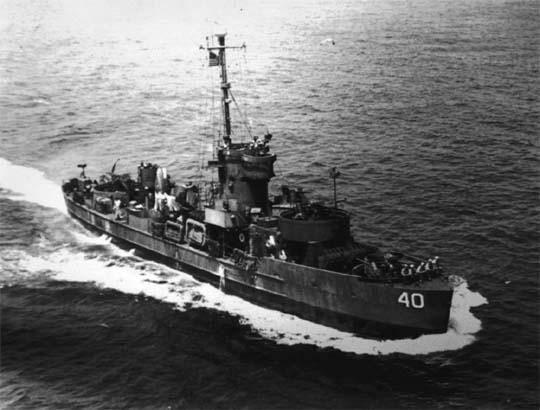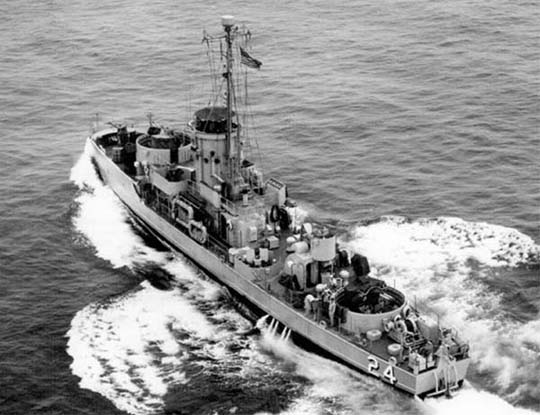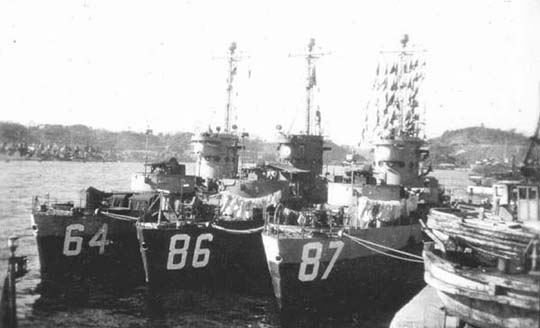Hondo
One Too Many
- Messages
- 1,655
- Location
- Northern California
WWII gunboat brought home by vets from Thailand as memorial
The last warship from World War II came home Tuesday to the United States.
It was not a proud battleship, not a mighty aircraft carrier. It was the former LCS(L) 102, a gunboat, a ship so small it didn't even have a name. They called ships like this "mighty midgets" - gunnery support ships that served with honor in the last battles of the war in the Pacific. A San Francisco man and his shipmates saved the little ship and plan to make it a memorial.
The ship sailed through the Golden Gate as deck cargo, riding piggyback aboard a much larger freighter on a 7,900 mile voyage from Thailand.
The mighty midget is too old - it turned 63 this year - and too small - it is only 158 feet long - to sail across the Pacific under its own power.
The LCS was tough enough when it was new. Bristling with guns and rocket launchers, the gunboats were used for close gun support in invasion landings, or as picket ships to protect the fleet from suicide bombers in places like Okinawa.
Now the LCS 102 will be a memorial at Mare Island in Vallejo, the last of the little ships that played a big role in the war.
It was saved for preservation by Bill Mason and his friends, who served on ships exactly like the LCS 102 and never forgot. Mason, who is 82 now, is an emeritus professor at San Francisco State University. He served aboard an LCS for nearly two years, a wartime experience seared in his memory.
"We are not here to glorify what we did," he said. "But we just don't want our ship to disappear."
Mason stood at Lands' End at the San Francisco end of the Golden Gate for four hours to watch his ship come in around 9:30 p.m. Tuesday. The mighty midget was aboard the Da Fu, a heavy-lift ship that flies the flag of Panama, has a Chinese crew and is owned by a company in the Netherlands.
"It was great to see it," said Mason, chairman of a group of LCS veterans who found the last of the little ships, got it turned over to them, and arranged for transportation to the United States.
He likes to talk about the ships. There were 130 of them, all pretty much identical.
They were all built in the last two years of the war and were designed for close inshore artillery support during island invasions. They carried anti-aircraft guns, machine guns and 10 rocket launchers. They were small enough so they could go in close to shore and tough enough to drive off bigger ships.
They served in the Philippines, in the invasion of Iwo Jima, and most notably in the Okinawa campaign.
Tokyo Rose, the famous Japanese radio broadcaster, called them "miniature destroyers." The American Navy called them "mighty midgets."
Mason served on LCS 86. "When I first saw it, I thought, 'It's awfully small. Are we gonna take this thing across the ocean?' "
In truth, the LCS gunboats were smaller and slower than most San Francisco Bay ferryboats.
"We had 65 enlisted men aboard and six officers. We were from all walks of life. I have never been closer to anyone than I was to those men."
The men shared two showers - when there was enough fresh water.
Mason was 18 when he went aboard. "We were kids right out of high school, fighting a war," he said. "What did we know? We learned on the job."
By the summer of 1945, the LCS ships were on duty on the farthest edge of the U.S. fleet, attacking Okinawa. The Japanese were desperate to stop the Americans, so they threw kamikaze suicide planes at them.
Mason can still see those planes coming, can still feel the 20mm guns firing, can still see the burned, dead men on a ship hit by a kamikaze. They had gone alongside to help put out the fires. "I still see those dead guys, frozen in position," he said.
Mason and his shipmates not only had affection for each other, but for their ship.
The ship was their home, the place where they fought, their life. " 'This is our ship,' we thought. 'It's gonna take care of you. It's gonna get you home.'
"That's why they call ships 'she.' It's like your mother."
After the war, life went on for the sailors. They had yearly reunions, but they never forgot those ships. Eventually, they found the LCS 102, serving in the Thai navy.
When World War II war ended, the ship was lent to the Japanese Self Defense Force, and then to Thailand.
The little ship served as His Thai Majesty's Ship Nakha for more than 40 years. Finally, at the end of its useful life, the vets, who had formed a nonprofit organization called the National Association of USS LCS(L) 1-130, talked the U.S. State Department and the Thais into giving the ship to them.
"I talked to the Thai navy officer who was the first captain of this ship in the Thai navy. He's retired himself now but he thought the same way about this ship that we do. They were sorry to see it go."
The little ship will be unloaded today from the freighter Da Fu while it is anchored in San Francisco Bay. Then it will be towed to Vallejo.
The Mare Island National Historic Park will accept the ship at ceremonies Nov. 10.
Restoring the ship and sailing it to San Francisco Bay cost about $3 million; the National Association of USS LCS(L) 1-130 retrieval fund can be reached through Mason, at 2960 20th Ave., San Francisco, 94132.
Online resources
For more information about the mighty midgets, go to:
links.sfgate.com/ZXN
http://www.sfgate.com/cgi-bin/artic...26/BALLSE1UQ.DTL&hw=carl+nolte&sn=001&sc=1000
The last warship from World War II came home Tuesday to the United States.
It was not a proud battleship, not a mighty aircraft carrier. It was the former LCS(L) 102, a gunboat, a ship so small it didn't even have a name. They called ships like this "mighty midgets" - gunnery support ships that served with honor in the last battles of the war in the Pacific. A San Francisco man and his shipmates saved the little ship and plan to make it a memorial.
The ship sailed through the Golden Gate as deck cargo, riding piggyback aboard a much larger freighter on a 7,900 mile voyage from Thailand.
The mighty midget is too old - it turned 63 this year - and too small - it is only 158 feet long - to sail across the Pacific under its own power.
The LCS was tough enough when it was new. Bristling with guns and rocket launchers, the gunboats were used for close gun support in invasion landings, or as picket ships to protect the fleet from suicide bombers in places like Okinawa.
Now the LCS 102 will be a memorial at Mare Island in Vallejo, the last of the little ships that played a big role in the war.
It was saved for preservation by Bill Mason and his friends, who served on ships exactly like the LCS 102 and never forgot. Mason, who is 82 now, is an emeritus professor at San Francisco State University. He served aboard an LCS for nearly two years, a wartime experience seared in his memory.
"We are not here to glorify what we did," he said. "But we just don't want our ship to disappear."
Mason stood at Lands' End at the San Francisco end of the Golden Gate for four hours to watch his ship come in around 9:30 p.m. Tuesday. The mighty midget was aboard the Da Fu, a heavy-lift ship that flies the flag of Panama, has a Chinese crew and is owned by a company in the Netherlands.
"It was great to see it," said Mason, chairman of a group of LCS veterans who found the last of the little ships, got it turned over to them, and arranged for transportation to the United States.
He likes to talk about the ships. There were 130 of them, all pretty much identical.
They were all built in the last two years of the war and were designed for close inshore artillery support during island invasions. They carried anti-aircraft guns, machine guns and 10 rocket launchers. They were small enough so they could go in close to shore and tough enough to drive off bigger ships.
They served in the Philippines, in the invasion of Iwo Jima, and most notably in the Okinawa campaign.
Tokyo Rose, the famous Japanese radio broadcaster, called them "miniature destroyers." The American Navy called them "mighty midgets."
Mason served on LCS 86. "When I first saw it, I thought, 'It's awfully small. Are we gonna take this thing across the ocean?' "
In truth, the LCS gunboats were smaller and slower than most San Francisco Bay ferryboats.
"We had 65 enlisted men aboard and six officers. We were from all walks of life. I have never been closer to anyone than I was to those men."
The men shared two showers - when there was enough fresh water.
Mason was 18 when he went aboard. "We were kids right out of high school, fighting a war," he said. "What did we know? We learned on the job."
By the summer of 1945, the LCS ships were on duty on the farthest edge of the U.S. fleet, attacking Okinawa. The Japanese were desperate to stop the Americans, so they threw kamikaze suicide planes at them.
Mason can still see those planes coming, can still feel the 20mm guns firing, can still see the burned, dead men on a ship hit by a kamikaze. They had gone alongside to help put out the fires. "I still see those dead guys, frozen in position," he said.
Mason and his shipmates not only had affection for each other, but for their ship.
The ship was their home, the place where they fought, their life. " 'This is our ship,' we thought. 'It's gonna take care of you. It's gonna get you home.'
"That's why they call ships 'she.' It's like your mother."
After the war, life went on for the sailors. They had yearly reunions, but they never forgot those ships. Eventually, they found the LCS 102, serving in the Thai navy.
When World War II war ended, the ship was lent to the Japanese Self Defense Force, and then to Thailand.
The little ship served as His Thai Majesty's Ship Nakha for more than 40 years. Finally, at the end of its useful life, the vets, who had formed a nonprofit organization called the National Association of USS LCS(L) 1-130, talked the U.S. State Department and the Thais into giving the ship to them.
"I talked to the Thai navy officer who was the first captain of this ship in the Thai navy. He's retired himself now but he thought the same way about this ship that we do. They were sorry to see it go."
The little ship will be unloaded today from the freighter Da Fu while it is anchored in San Francisco Bay. Then it will be towed to Vallejo.
The Mare Island National Historic Park will accept the ship at ceremonies Nov. 10.
Restoring the ship and sailing it to San Francisco Bay cost about $3 million; the National Association of USS LCS(L) 1-130 retrieval fund can be reached through Mason, at 2960 20th Ave., San Francisco, 94132.
Online resources
For more information about the mighty midgets, go to:
links.sfgate.com/ZXN
http://www.sfgate.com/cgi-bin/artic...26/BALLSE1UQ.DTL&hw=carl+nolte&sn=001&sc=1000





